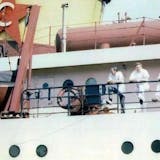Fishing guide Jason Dudek pulled a dead bass with what looked like several knife wounds out of Green Lake in Spicer, Minn. Several more keeper-sized smallmouths were found floating in the lake over the past month, all with the same strange wounds.
On any other lake, in any other part of the country, a handful of dead fish probably wouldn't raise eyebrows. But because it was this lake, Dudek and other anglers immediately feared that a long-simmering war was back.
"I'm not sure why it's come back," said Dudek, who posted his suspicions in a video on Facebook. "But someone is slicing and killing bass again. It's such a waste."
But the state Department of Natural Resources (DNR) doesn't believe that Green Lake's bass were intentionally killed this time around, as they were in the early 2000s by walleye fishermen upset over the prevalence of bass.
The fish may have been killed by something else, something that could be lurking in the live wells of the bass fishermen's own boats.
"I don't know if it makes me happy or sad," said Dave Coahran, the DNR's area supervisor. "But I'm glad in one sense: that the old war of bass vs. walleye wasn't resurrecting itself again like it did 15 years ago."
Scientist have been dissecting fish in a lab to find out how they died, as anglers adjust to the subtle and not-so-subtle ways Minnesota's lakes are changing.
Green Lake — about 110 miles west of Minneapolis — had always been a good walleye fishing lake. But by the late 1990s, it was an excellent one. The water temperature and clarity were in a sweet spot for walleye then, staying just cold and murky enough to make it ideal, Coahran said. There was also plenty of their favorite prey, perch that grew up to 6 or 7 inches long. There were relatively few smallmouth bass, one of the walleye's top competitors.


